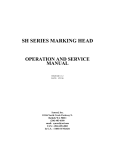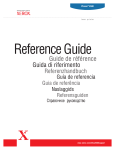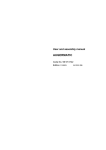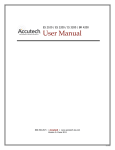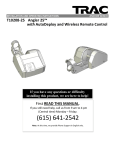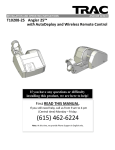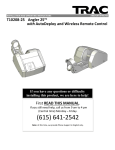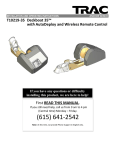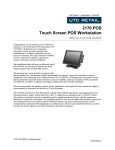Download Polaris Cab User's Manual
Transcript
INSTALLATION & OWNER’S MANUAL Rev. K, p. 1 of 11 POLARIS FREEDOM CAB INSTALLATION INSTRUCTIONS FOR THE POLARIS RANGER (p/n 2876196-067) IMPORTANT: THIS ACCESSORY WEIGHS 340 POUNDS. PLEASE ADJUST THE VEHICLE PAYLOAD ACCORDINGLY. The contents of this manual are the property of the owner. Be sure to leave with the owner when installation is complete. Standard item with purchase of cab: one driver’s side wiper. Optional accessories available: passenger’s side wiper, work lights, and strobe light. Multiple U.S. and Foreign Patents Pending Rev. K, p. 2 of 11 DESIGN CONCEPT Curtis Cabs feature an assembly of parts designed for your vehicle which require adjustment and alignment of components to accommodate vehicle variations and provide proper weather protection. For accurate installation, proper operation, and years of satisfaction, please read and understand the installation instructions. From all of us at Curtis, we thank you for choosing our product. GENERAL INFORMATION Helpful Reminders: A. B. C. D. Refer to parts diagram to help identify parts during assembly process. Leave all bolts loose for later adjustment unless otherwise specified. Read and understand all instructions before beginning. Apply a clear silicone sealant to seal any minor gaps that may occur due to vehicle variations. Curtis Customer Service Hotline 1-800-343-7676 (ext. 1) ADDED WEIGHT Curtis Cabs, blades and general accessories add additional weight to the base vehicle. All Curtis accessory weights are listed in product brochures. Deduct the accessory's total weight from the vehicle's rated capacity and never exceed the vehicle's rated capacity including driver and passenger. Exposure to Carbon Monoxide can Cause illness, serious injury or death. Never operate vehicle if suspicious of Carbon Monoxide. Inspect exhaust system for leaks monthly. Leaks can result from loose connections, corrosion, cracks or other damage to the exhaust manifold. If leaks are found, repair or replace exhaust system. Do not use vehicle until repair or replacement is complete. DO NOT TRAVEL WITH WINDSHIELD IN FULL OPEN POSITION. TOOLS REQUIRED: 1/4” & 3/8” DRIVE RATCHETS 3/8” DEEP SOCKET (3/8” DRIVE) 1/2” SOCKET (3/8” DRIVE) 10mm SOCKET (3/8” DRIVE) 5/32” AND 3/16” ALLEN WRENCHES HAND DRILL #2 PHILLIPS HEAD BIT TO USE IN DRILL #2 and #3 PHILLIPS HEAD SCREWDRIVERS T27 TORX BIT BAR CLAMP Rev. K, p. 3 of 11 WARNING! Gasoline—Flammable! Explosive! Do not operate gasoline vehicle in an enclosed area without proper ventilation. The engine produces carbon monoxide, which is an odorless, deadly poison. This vehicle and enclosure will not provide protection from rollover, flying objects, lightening, or other hazards. If caught in a storm, exit the vehicle and seek shelter in accordance with applicable safety guidelines for your location. Only trained technicians should service or repair the enclosure. Anyone doing repairs or service should have knowledge and experience in electrical and mechanical repair. The appropriate instructions must be used when performing maintenance, service, or installation. Follow the procedures exactly as stated in these instructions, and heed all DANGER, WARNING, and CAUTION statements both in this instruction manual as well as those posted on the vehicle. Prior to servicing the vehicle, turn the key switch to OFF and set the parking brake. Always wear safety glasses or approved eye protection when servicing the vehicle. Moving parts! Do not attempt to service the vehicle while it is running. Hot! Do not attempt to service while engine, exhaust system, or motor are hot. Failure to heed this warning could result in severe burns. Use insulated tools when working near batteries or electrical connections. Avoid shorting components or wiring. If wires are removed or installed, make sure wiring and wire harness are properly routed and secured. Failure to properly route and secure wiring could result in vehicle malfunction, property damage, personal injury, or death. Rev. K, p. 4 of 11 1. VEHICLE PREP. 1.1 Using a T27 Torx bit, remove three (3) original equipment screws on each side of the vehicle floorboard as shown in fig. 1.1. Save these six (6) bolts for reinstallation in step 3.3. Note: these are self-tapping screws that were factory installed. Use care when removing and re-installing to avoid cross-threading or damaging the female threads underneath the vehicle floorboard. 2. “P” CLAMPS 2.1 Install a total of seven (7) “P” clamps as follows: per fig. 2.1, place three (3) clamps on the rear tubular frame oriented as shown. One in the center of the tubular frame and one per side on the outer edges. Per fig. 2.1.1, install two (2) clamps on each side tubular frame oriented as shown. The front most clamp can be close to the front welded joint and the rear most clamp can be 13” behind the front one. Hardware will be installed in step 6.2. 3. remove and save 3 bolts per side before installing side frame Fig. 1.1 View from passenger’s side flat portion towards the sky SIDE FRAME & DOOR ASS’Y. 3.1 With assistance, place the side frame assembly in place on top of the vehicle floorboard per fig. 3.1. Attach the middle front using the bracket shown, two 5/16-18 x 1” long hex head bolts, two internal tooth locking washers, and two flat steel washers into the factory installed threaded inserts. See fig. 3.1.1. Hand tighten only. place floorboard of side frame onto floorboard of vehicle lining up 3 holes Ref. Fig. 2.1 View from passenger’s side flat portion towards the ground Fig. 3.1 View from passenger’s side Ref Ref. welded joint Fig. 2.1.1 View from passenger’s side front clamp Fig. 3.1.1 View from driver’s side Rev. K, p. 5 of 11 3. SIDE FRAME & DOOR ASS’Y. (cont’d.) 3.2 Carefully open the door to the midway or slightly beyond position to gain access for installing the hip restraint bracket. Insert the tongue of the bracket as shown in fig. 3.2 and rotate the bracket up and install one 5/1618 x 1” long hex head bolt, one internal tooth locking washer, and one flat steel washer into the factory installed weld nut. Leave bolt loose. 3.3 Re-install the three original equipment floorboard screws through the bolt holes in the floorboard of the side frame. See fig. 3.3. Reminder: these are self-tapping screws that were factory installed. Use care to avoid cross-threading or damaging the original female threads underneath the vehicle floorboard. Leave bolts loose. 3.4 Repeat steps 3.1 through 3.3 for opposite side frame assembly. 4. WINDSHIELD SUPPORT 4.1 If installing optional work lights, pop the two Heyco plugs out and discard them. If not installing optional work lights, leave the plugs in place. With assistance, install the windshield support as shown in fig. 4.1. Install four 5/16-18 x 3/4” long hex head bolts, four internal tooth locking washers, and four flat steel washers. Factory installed weld nuts are provided on the tabs of the side frame. See right side of figure 4.1. Leave bolts loose. 5. WINDSHIELD 5.1 Have the following items ready: four 5/16-18 x 1 3/4” long flat head bolts, four steel washers, four 5/1618 locknuts, and two plastic spacer blocks. With assistance, place the windshield in place on the windshield support with the 3/4” thick plastic spacer blocks underneath the plastic hinges for mounting up against the outer surface of the windshield support per fig. 5.1. Adjust windshield seal to the vehicle hood with side latches engaged and tighten. NOTE: hinges are plastic components. Do not overtighten. Torque to 7 ft.-lbs. max.. WARNING: do not travel with windshield in full open position. Ref.: hip restraint tube Ref. bent tab without hole slides into receiving slot Fig. 3.2 View from passenger’s side re-install 3 bolts per side using care to avoid damaging female threads underneath vehicle floorboard Fig. 3.3 View from passenger’s side side frame mounting holes Fig. 4.1 View from driver’s side 5.2 Install the supplied nut covers (qty.: 4) on the locknuts inside the cab (front windshield hinge bolts). 3/4” thick plastic spacer Fig. 5.1 View from driver’s side Rev. K, p. 6 of 11 6. TIGHTEN ALL BOLTS flat portion towards the ground 6.1 Tighten all cab bolts at this time. Reminder: do not over-tighten the six (6) self-tapping floorboard screws. 6.2 Use a small bar clamp to hold the side frame against the top side tubular frame. Using a drill and a Phillips head bit, install two self-drilling and self-tapping screws through the “P” clamps and into the underside of the side frame tubing as shown in figure 6.2. Do not over-torque these screws. Reminder: be sure these two clamps are spread apart approximately 13”. One should be just ahead of the ball stud and the other one as far forward as the tubular frame will allow before the welded seam. 7. Ref. welded joint Fig. 6.2 View from passenger’s side REAR WINDOW IMPORTANT INSTALLATION NOTICE! To facilitate the rear panel installation to the cab, it is recommended to lubricate the perimeter rubber seal of the rear panel with a silicone or Armor All protectant/lubricant (or similar) non-flammable lubricant. To prevent lubricant from contaminating the plastic rear panel, spray lubricant onto a rag and in turn use the rag to lubricate the perimeter rubber of the rear panel. This will allow the full seating of the rear panel in the opening which is necessary for proper hole alignment. 7.1 Lift the bed. With assistance, place the rear window in position. Fasten using four 1/4-20 x 1 1/4” long Truss head, Phillips head bolts and four fender washers into factory installed weld nuts on the rear tabs on the side frames. Snug up the bolts. Do not over-compress the rubber bushings. 7.2 Secure the vinyl filler by applying self-adhesive backed velcro to the vehicle where needed. Note: selfadhesive backed velcro should be applied to a clean, dry surface at room temperature. See fig. 7.2 for general locations. At location “a”, use a long piece along the bottom; at location “b”, use a small piece; and at location “c”, use a long piece straight up to rear window. Repeat “b” and “c” for opposite side. Attach the vinyl filler to the newly installed hook velcro on the vehicle. 8. a c b Fig. 7.2 View of driver’s side lower rear corner controls to be towards the front Fig. 8.1 View from passenger’s side ROOF & CONSOLE ASSEMBLY 8.1 Temporarily remove and save 2 fender washers and 2 locknuts where indicated in fig. 8.6.1 on the next page. With assistance, place the roof/console assembly in place oriented so the controls are towards the front of the vehicle. See figure 8.1. 8.2 If installing optional work lights, feed the two wires through the hole in the windshield support where the Heyco plugs were located. See figure 8.2. If not installing optional work lights, push the wiring back into the holes of the overhead console. Ref.: work light wires and bracket mounting holes Fig. 8.2 View from driver’s side Rev. K, p. 7 of 11 8. ROOF & CONSOLE ASS’Y. (cont.) 8.3 A driver’s side wiper is provided. Place the driver’s side wiper wire below the front tubular frame as shown in fig. 8.3. If installing an optional passenger’s side wiper, place that wire below the front tubular frame as well. If not installing a passenger’s side wiper, push the passenger’s side wiring up into the console to hide it. Caution: If installing a second wiper, double check that both wipers have a maximum 85 degree sweep to avoid interference. The motor should have a sticker on it indicating the degree of sweep. 8.4 If not installing optional work lights, install four 1/4-20 x 3/4” long Truss head, Phillips head bolts into factory installed threaded inserts in the front of the overhead console. Leave bolts loose. Note: two per side where the work light mounting bracket would be mounted. See figure 8.2 on the previous page. loomed wiper wires to be underneath the front tubular frame Fig. 8.3 View from driver’s side 8.5 OPTIONAL: If installing the optional work lights (kit p/n 2876382), discard the two brackets with the 3hole pattern on the light and use the supplied bracket with the 4-hole pattern. See fig. 8.5. Install work light brackets oriented as shown in figure 8.5.1. Use four 1/420 x 3/4” long Truss head, Phillips head bolts into factory installed threaded inserts in the front of the overhead console. Leave bolts loose. 8.6 Install three 1/4-20 x 3/4” long Truss head, Phillips head bolts through the three rear “P” clamps and into the threaded inserts in the rear of the overhead console. See fig. 8.6. Tighten the previously installed four bolts (2 per side) holding the front of the overhead console to the windshield support. Per fig. 8.6.1 below, re-install 2 fender washers and 2 locknuts (temporarily removed in step 8.1) to secure the middle front of the roof/overhead console assembly to the metal windshield support. Do not overtighten. discard the bracket and carriage bolt that is on the light Fig. 8.5 Optional Work Light and Bracket tabs with holes should be pointing towards the sky 8.7 OPTIONAL cont’d.: Attach the optional work lights to the mounting brackets using the 1 7/8” long hex head bolts that came on the set of work lights. Connect the four wires (two per light) (male to female bullet connectors). Fig. 8.5.1 Optional work light bracket re-install fender washers and locknuts and tighten so that the plastic of the overhead console is snug against the sheetmetal windshield support Fig. 8.6.1 View from front of vehicle factory installed threaded insert Fig. 8.6 View from passenger’s side Rev. K, p. 8 of 11 this end towards the ground 9 GAS SHOCKS AND WIRING 9.1 Open the windshield and attach the two gas shocks as shown in fig. 9.1 with the rod end of the gas shock pointing down. Snap the gas shock onto the ball studs. Leave the windshield in the open position. 9.2 Run the loomed battery wires over the front tubular frame, down along the side tubular frame and into the gap behind the hood as shown in fig. 9.2. Secure the loomed wire to the tubular frame using three of the supplied cable ties. Snip off excess length of cable tie if desired. Lift the hood of the vehicle. Using a 10mm socket or Philips screwdriver, connect the long, red, positive wire and the long, black, negative wire to the battery. Wires are labeled. Connect the key-controlled wire as follows: using a 3/8” deep socket, temporarily remove the nut on the top threaded stud as shown in fig. 9.2.1. Place the supplied ring terminal onto the stud and reinstall the original nut and tighten. Ref.: the top stud should already have an orange wire with a white stripe. This is the vehicle’s key-controlled wire. 9.3 Note: there are two (2) extra wires with female bullet connectors that are only used if a heater is being installed. The blue wire is for the low speed and the gray wire is for the high speed. When finished with the wire connections, coil up the extra length of loomed wire and use a cable tie to secure the wires in place as desired. 10. Fig. 9.1 Gas shock for windshield run loomed wire into this gap Fig. 9.2 View from driver’s side FINISHING TOUCHES 10.1 Make sure the rubber flaps are appropriately sealing against the sides of the plastic hood of the vehicle. See figure 10.1. 10.2 Using a 5/32” Allen wrench, set the antenna at a desired angle and re-tighten the set screw. 10.3 Install wiper per instructions included in the wiper kit. One wiper is included with the cab. A second wiper is available as an additional option. Caution: If installing a second wiper, double check that both wipers have a maximum 85 degree sweep to avoid interference. The motor should have a sticker on it indicating the degree of sweep. 10.4 Note: extra hardware has been provided in case they get lost. Discard extras such as washers, locknuts, “P” clamps, cable ties, etc. It is recommended that with a cab installed, the vehicle should be trailered facing backwards. attach to the top threaded stud that has the orange wire with white stripe Fig. 9.2.1 View from driver’s side rubber flap Fig. 10.1 View from driver’s side Rev. K, p. 9 of 11 CARE AND MAINTENANCE (IMPORTANT: be sure to leave this page with the owner once installation is complete. Check and tighten hardware after 40 hours of operation. Periodically inspect and tighten hardware for the remainder of the unit’s service life. IMPORTANT CLEANING INFORMATION Keep the enclosure components clean in order to prevent dust and dirt from forming an unattractive film. The life of your acrylic windows, doors, and body panels depends upon following these care procedures: REAR ACRYLIC WINDOW: 1) NEVER USE AN ALCOHOL-BASED PRODUCT FOR CLEANING. Do not use WINDEX, GLASS PLUS, FANTASTIC, etc. Use of these products will result in deterioration of the acrylic item. 2) Wash with a mild soap or detergent using your bare hands to free or dislodge any caked-on dirt or other foreign particles. 3) A soft, grit-free cloth, sponge, or chamois may be used but only as a means of carrying water to the windows. 4) The interior should be lightly dusted (NOT WIPED) with a clean soft cloth or chamois. The cloth or chamois should be kept free of grit by frequent rinsing in clean water. 5) Grease and oil may be removed with kerosene. 6) Novus I and Novus II are recommended plastic cleaners for acrylic units and can be used to remove light scratches. GLASS WINDOWS: 1) Windex and other glass cleaners can be used on glass windows. DOORS AND BODY PANELS: 1) NEVER USE AN ABRASIVE DETERGENT/VEHICLE CLEANER OR A WIRE BRISTLED BRUSH. Do not use any CITRUS BASED CLEANERS such as orange or lemon. Use of these products will cause the plastic to become permanently damaged. 2) Clean the plastic enclosure surfaces thoroughly with warm soapy water and a COTTON cloth or chamois. Be sure to use mild soap, specifically a dish liquid or equivalent. Clean in a light circular motion for best results. 3) Use EXTRA CAUTION when cleaning the interior of the enclosure. The interior is more sensitive than the exterior because the exterior has an extra coating for U.V. stability. 4) Remove grease and oil with mineral spirits and a COTTON cloth or chamois. WARNING: do not travel with windshield in full open position. It is recommended that with a cab installed, the vehicle should be trailered facing backwards. Curtis Customer Service Hotline: 1-800-343-7676 (ext. 1)











